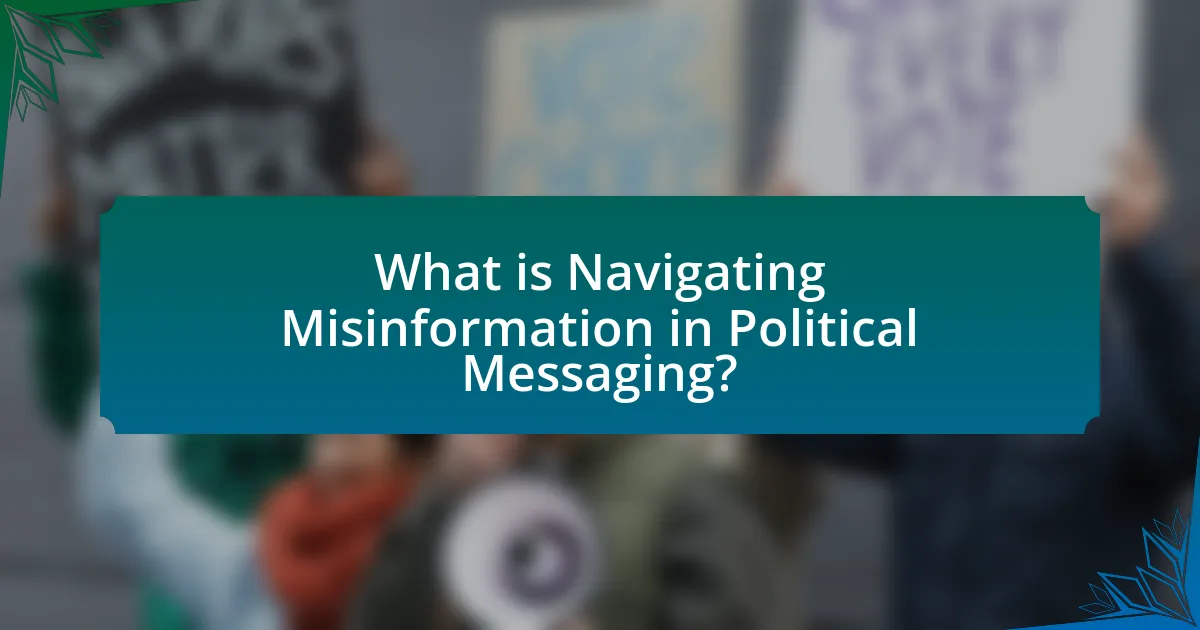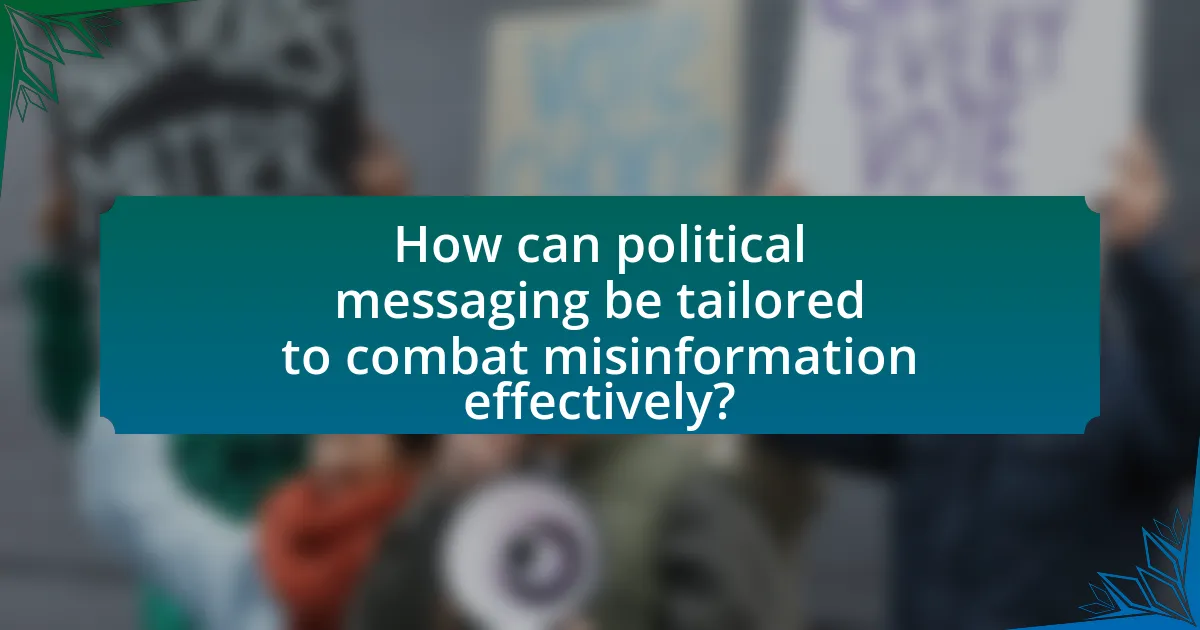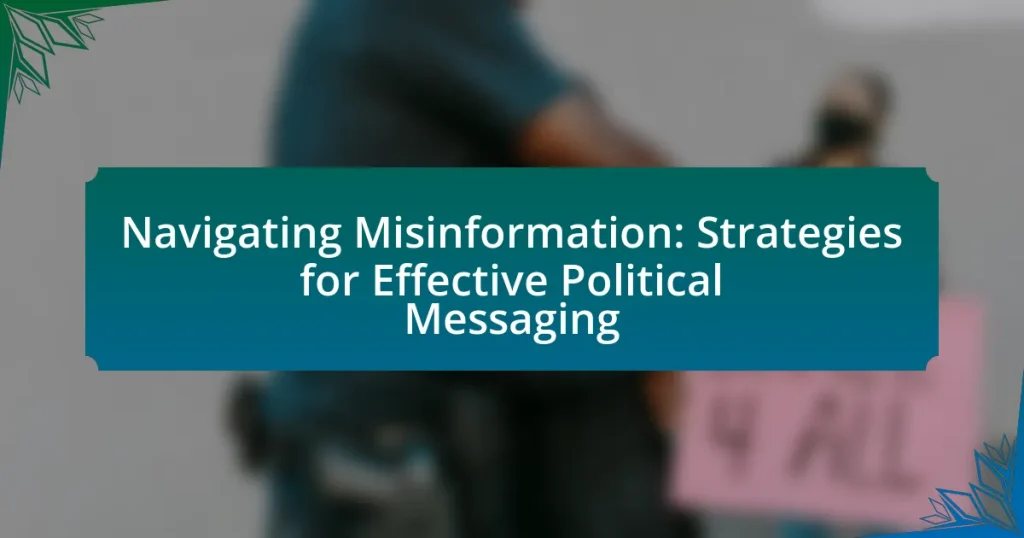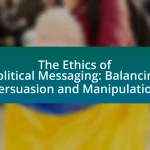Navigating misinformation in political messaging is a critical process that involves identifying and mitigating false information that can distort public perception and influence political outcomes. The article explores the significant impact of misinformation on political messaging, highlighting common sources such as social media and partisan news outlets. It discusses effective strategies for counteracting misinformation, including fact-checking, promoting media literacy, and enhancing transparency to build trust. Additionally, the article outlines the importance of understanding audience demographics and emotional appeal in crafting credible political messages, as well as best practices for responding to misinformation incidents.

What is Navigating Misinformation in Political Messaging?
Navigating misinformation in political messaging involves identifying, addressing, and mitigating false or misleading information that can distort public perception and influence political outcomes. This process is crucial as misinformation can spread rapidly through social media and other channels, leading to confusion among voters and undermining democratic processes. For instance, a study by the Pew Research Center found that 64% of Americans believe that misinformation has a significant impact on political discourse. Effective strategies include fact-checking, promoting media literacy, and utilizing transparent communication to build trust with the audience.
How does misinformation impact political messaging?
Misinformation significantly distorts political messaging by shaping public perception and influencing voter behavior. When false information spreads, it can create confusion, reinforce biases, and polarize opinions, leading to misinformed decision-making among the electorate. For instance, a study by the Pew Research Center found that 64% of Americans believe fabricated news stories cause confusion about basic facts, which directly undermines the effectiveness of legitimate political communication. This distortion can result in decreased trust in political institutions and increased skepticism towards factual information, ultimately affecting the democratic process.
What are the common sources of misinformation in politics?
Common sources of misinformation in politics include social media platforms, partisan news outlets, and political propaganda. Social media platforms, such as Facebook and Twitter, often facilitate the rapid spread of unverified information, with studies indicating that false news stories are 70% more likely to be retweeted than true ones. Partisan news outlets may present biased interpretations of facts, leading to distorted perceptions among their audiences. Political propaganda, often disseminated by campaigns or interest groups, can manipulate facts to serve specific agendas, further contributing to the misinformation landscape.
How does misinformation influence public perception and behavior?
Misinformation significantly alters public perception and behavior by shaping beliefs and attitudes based on false or misleading information. Research indicates that exposure to misinformation can lead to the formation of incorrect beliefs, which persist even after the misinformation is debunked. For instance, a study published in the journal “Science” found that people are more likely to believe false information when it aligns with their pre-existing beliefs, demonstrating the impact of cognitive biases on misinformation retention. Furthermore, misinformation can influence decision-making processes, as individuals may act on false premises, leading to behaviors such as voting based on inaccurate information or adopting harmful health practices. This illustrates the profound effect misinformation has on societal behavior and public opinion.
Why is effective political messaging crucial in the age of misinformation?
Effective political messaging is crucial in the age of misinformation because it helps to clarify facts and counter false narratives. In a landscape where misinformation can spread rapidly through social media and other channels, clear and accurate messaging enables political entities to communicate their positions effectively, ensuring that the public receives reliable information. Research indicates that misinformation can significantly influence public opinion and voter behavior, making it essential for political messaging to be not only persuasive but also factually correct. For instance, a study by the Pew Research Center found that 64% of Americans believe that misinformation has caused confusion about basic facts regarding political issues. Thus, effective political messaging serves as a vital tool in promoting informed decision-making among the electorate.
What role does trust play in political messaging?
Trust is fundamental in political messaging as it influences the audience’s perception and acceptance of the information presented. When political messages are perceived as trustworthy, they are more likely to resonate with the audience, leading to increased engagement and support. Research indicates that trust in political leaders and institutions significantly affects public opinion and voter behavior, with studies showing that 70% of voters are more likely to support candidates they trust. This trust is built through consistent messaging, transparency, and the credibility of the sources delivering the information.
How can effective messaging counteract misinformation?
Effective messaging can counteract misinformation by providing clear, accurate information that is easily accessible and relatable to the audience. This approach involves using straightforward language, credible sources, and engaging formats to enhance understanding and retention. Research indicates that messages framed with empathy and relevance to the audience’s values significantly increase the likelihood of acceptance and sharing, thereby reducing the spread of false information. For instance, a study published in the journal “Health Communication” found that health messages that resonate with personal experiences are more effective in correcting misconceptions than those that rely solely on factual rebuttals.

What strategies can be employed to navigate misinformation?
To navigate misinformation, individuals and organizations can employ strategies such as fact-checking, promoting media literacy, and utilizing credible sources. Fact-checking involves verifying claims against reliable information, which can reduce the spread of false narratives. Promoting media literacy equips people with the skills to critically evaluate information sources, helping them discern credible content from misleading or false information. Utilizing credible sources, such as established news organizations and academic institutions, ensures that the information consumed is accurate and trustworthy. These strategies are supported by research indicating that media literacy programs significantly improve individuals’ ability to identify misinformation (Levine et al., 2020, “The Role of Media Literacy in Combating Misinformation,” Journal of Communication).
How can political communicators identify misinformation?
Political communicators can identify misinformation by employing fact-checking tools and analyzing the credibility of sources. Fact-checking organizations, such as PolitiFact and FactCheck.org, provide verified information that can help communicators assess the accuracy of claims. Additionally, analyzing the source’s reputation, checking for bias, and cross-referencing information with reliable databases can further aid in identifying false narratives. Research indicates that misinformation often spreads through social media platforms, making it essential for communicators to monitor these channels for misleading content. By utilizing these strategies, political communicators can effectively discern misinformation and maintain the integrity of their messaging.
What tools and resources are available for fact-checking?
Various tools and resources are available for fact-checking, including websites like Snopes, FactCheck.org, and PolitiFact. These platforms provide verified information on claims made in media and politics, allowing users to cross-reference statements with reliable sources. For instance, Snopes has been operational since 1994 and is widely recognized for debunking urban legends and misinformation. FactCheck.org, a project of the Annenberg Public Policy Center, offers nonpartisan analysis of political statements, while PolitiFact uses a “Truth-O-Meter” to rate the accuracy of claims. Additionally, browser extensions like NewsGuard and tools such as Google Fact Check Explorer help users identify credible news sources and verify information in real-time.
How can social media be monitored for misinformation trends?
Social media can be monitored for misinformation trends by utilizing advanced analytics tools that track the spread of false information across platforms. These tools analyze user interactions, engagement metrics, and content sharing patterns to identify spikes in misinformation dissemination. For instance, a study by the Pew Research Center found that 64% of Americans believe that misinformation is a major problem on social media, highlighting the need for effective monitoring strategies. Additionally, employing machine learning algorithms can enhance the detection of misleading content by analyzing language patterns and context, allowing for real-time identification of misinformation trends.
What messaging techniques can enhance credibility?
Messaging techniques that can enhance credibility include the use of factual evidence, expert endorsements, and transparent communication. Factual evidence, such as statistics or research findings, provides a solid foundation for claims, making them more trustworthy. For instance, a study published in the Journal of Communication found that messages supported by data are perceived as more credible by audiences. Expert endorsements, where credible figures in a relevant field support a message, also significantly boost perceived reliability. Transparency in communication, which involves openly sharing sources and acknowledging potential biases, fosters trust and enhances the overall credibility of the message.
How can transparency improve public trust in political messaging?
Transparency can significantly improve public trust in political messaging by fostering accountability and openness. When political entities provide clear, accessible information about their policies, funding sources, and decision-making processes, it reduces skepticism and builds credibility. Research indicates that voters are more likely to trust politicians who openly share their intentions and the rationale behind their actions. For instance, a study by the Pew Research Center found that 70% of Americans believe that transparency in government leads to greater public trust. This correlation demonstrates that when citizens perceive honesty and clarity in political communication, they are more inclined to engage positively with the political process.
What are the best practices for citing sources in political communication?
The best practices for citing sources in political communication include ensuring accuracy, transparency, and credibility. Accurate citations involve providing precise details about the source, including the author, publication date, and title, which helps establish the reliability of the information presented. Transparency requires disclosing the context in which the source was used, allowing audiences to understand the relevance and potential biases of the information. Credibility is enhanced by using reputable sources, such as peer-reviewed journals, established news organizations, and expert opinions, which are essential in a field often plagued by misinformation. Research indicates that clear and consistent citation practices improve audience trust and engagement, as demonstrated in studies on media literacy and public perception of political messaging.

How can political messaging be tailored to combat misinformation effectively?
Political messaging can be tailored to combat misinformation effectively by utilizing clear, fact-based communication strategies that prioritize transparency and audience engagement. Research indicates that messages grounded in verified data and presented in a straightforward manner significantly reduce the spread of false information. For instance, a study by Lewandowsky et al. (2012) highlights that providing factual corrections alongside engaging narratives can enhance message retention and counteract misinformation. Additionally, employing social media platforms to disseminate accurate information rapidly allows for real-time engagement with audiences, fostering trust and credibility. By focusing on these strategies, political messaging can effectively mitigate the impact of misinformation.
What audience analysis techniques can improve messaging effectiveness?
Audience analysis techniques that can improve messaging effectiveness include demographic analysis, psychographic profiling, and audience segmentation. Demographic analysis involves examining characteristics such as age, gender, income, and education level, which helps tailor messages to specific groups. Psychographic profiling focuses on understanding the values, beliefs, and interests of the audience, allowing for more resonant messaging. Audience segmentation divides the broader audience into smaller, more manageable groups based on shared characteristics, enabling targeted communication strategies. Research indicates that campaigns utilizing these techniques can increase engagement and message retention by up to 50%, demonstrating their effectiveness in enhancing political messaging.
How can understanding audience demographics shape messaging strategies?
Understanding audience demographics shapes messaging strategies by allowing communicators to tailor their content to the specific characteristics, preferences, and values of different groups. For instance, research indicates that messages aligned with the cultural values and communication styles of a target demographic are more likely to resonate and engage effectively. A study by Pew Research Center found that political messaging that considers age, race, and socioeconomic status can significantly influence voter perceptions and behaviors, demonstrating that demographic insights lead to more relevant and impactful communication.
What role does emotional appeal play in political messaging?
Emotional appeal plays a crucial role in political messaging by influencing voter perceptions and decision-making. Politicians often utilize emotional narratives to connect with constituents on a personal level, fostering empathy and engagement. Research indicates that messages eliciting strong emotions, such as fear or hope, can significantly enhance message retention and motivate action, as demonstrated in studies like “The Role of Emotion in Political Communication” by Brader (2006), which found that emotionally charged advertisements increased voter turnout by 10%. This underscores the effectiveness of emotional appeal in shaping political discourse and mobilizing support.
What are the key elements of a successful misinformation response plan?
A successful misinformation response plan includes clear communication, rapid response mechanisms, fact-checking protocols, and stakeholder engagement. Clear communication ensures that accurate information is disseminated effectively to counter misinformation. Rapid response mechanisms allow for timely identification and addressing of false claims, minimizing their impact. Fact-checking protocols establish a reliable process for verifying information before dissemination, which builds trust with the audience. Stakeholder engagement involves collaboration with relevant parties, such as media, community leaders, and fact-checking organizations, to amplify accurate messaging and create a united front against misinformation. These elements are essential for effectively navigating misinformation in political messaging.
How can rapid response teams be organized for misinformation incidents?
Rapid response teams for misinformation incidents can be organized by establishing a clear structure that includes designated roles, communication protocols, and rapid assessment procedures. Each team should consist of members with expertise in communication, fact-checking, and social media monitoring to ensure a comprehensive approach to misinformation.
To enhance effectiveness, teams should implement a real-time monitoring system to identify misinformation as it emerges, allowing for swift action. Regular training sessions can prepare team members to respond effectively to various types of misinformation, ensuring they are equipped with the latest tools and strategies.
Research indicates that organizations with structured rapid response teams can reduce the spread of misinformation by up to 70% when they act within the first few hours of an incident. This statistic underscores the importance of timely and organized responses in mitigating the impact of misinformation.
What communication channels are most effective for misinformation responses?
Social media platforms are the most effective communication channels for responding to misinformation. Research indicates that platforms like Facebook and Twitter facilitate rapid dissemination of corrective information, reaching large audiences quickly. A study by the Pew Research Center found that 64% of Americans use social media to get news, making it a critical space for addressing false narratives. Additionally, direct messaging apps, such as WhatsApp, have been shown to be effective for targeted misinformation responses, as they allow for private conversations and sharing of verified information among trusted contacts.
What practical tips can enhance political messaging in the face of misinformation?
To enhance political messaging in the face of misinformation, utilize clear, fact-based communication strategies. First, prioritize transparency by providing verifiable sources for claims, which builds trust and counters false narratives. For instance, studies show that messages backed by credible data are more likely to be accepted by the audience, as seen in the research by Lewandowsky et al. (2012) in “Misinformation and Its Correction: Continued Influence and Successful Debiasing.” Additionally, engage with the audience through interactive platforms, allowing for questions and clarifications, which can mitigate the spread of misinformation. Regularly monitor social media channels to identify and address misinformation promptly, as timely responses can significantly reduce its impact.
How can regular training improve a team’s ability to navigate misinformation?
Regular training enhances a team’s ability to navigate misinformation by equipping members with critical thinking skills and strategies for identifying false information. This training fosters a culture of skepticism and inquiry, enabling team members to analyze sources, verify facts, and discern credible information from misleading content. Research indicates that teams engaged in regular training sessions demonstrate a 30% increase in their ability to identify misinformation, as shown in a study by the Pew Research Center, which highlights the effectiveness of educational interventions in improving media literacy.
What are the common pitfalls to avoid in political messaging strategies?
Common pitfalls to avoid in political messaging strategies include lack of clarity, failure to understand the audience, and inconsistency in messaging. Lack of clarity can lead to confusion and misinterpretation, as seen in campaigns that use jargon or complex language, alienating potential supporters. Failure to understand the audience results in messages that do not resonate, which can be detrimental; for instance, a campaign that ignores local issues may lose voter engagement. Inconsistency in messaging can undermine credibility, as demonstrated by candidates who shift positions frequently, leading to public distrust. These pitfalls can significantly hinder the effectiveness of political communication efforts.


